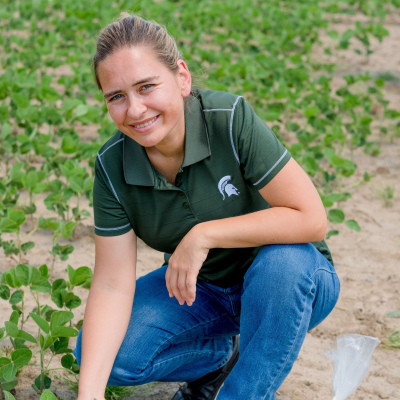Marisol Quintanilla
Bio
Dr. Marisol Quintanilla is an applied nematologist at Michigan State University. She grew up on her family’s farm in Chile, which produced table grapes and a variety of crops, before earning her master’s and doctoral degrees at MSU under MSU nematologist Dr. George Bird. She later worked at Northern Marianas College and the University of Hawaii, where she gained extensive experience with specialty crop growers. Her current program integrates research and extension to address nematode management in Michigan’s field, vegetable, fruit and ornamental crops, with an emphasis on soil health and sustainable practices.
Concentrations
-
Nematodes
-
Plant Parasitic Nematodes
-
Soil Health
Courses Taught
ENT451: Insect Physiology
Structure/function of insect physiological systems; Molecular mechanisms underlying insect development; Physiological evolution in insects.
Research
Quintanilla’s research focuses on applied solutions to plant-parasitic nematodes that can cause significant crop losses. Her work evaluates both conventional and biorational products for nematode control, explores resistant crop varieties and considers how management practices affect soil health and beneficial organism populations. She collaborates with faculty across disciplines to develop practical strategies for growers and communicates findings through extension programs, publications and direct outreach to Michigan’s agricultural community.
Learn more about Applied Nematology, Ecology and Acoustical Signatures research at MSU.
Extension
Quintanilla leads statewide extension efforts to provide growers and agricultural professionals with research-based strategies for nematode management. She shares information on nematode exclusion, sustainable control methods, soil health and host resistance through farm visits, field days, workshops, extension meetings, videos, publications and digital resources. She also partners with other faculty and extension agents to organize nematode education programs, ensuring that science-based solutions are accessible and applicable to growers across Michigan.
Publications
Related Work
-
How do pre-plant soil treatments improve growth and control nematodes in cherry orchards?
Published on May 29, 2025
-
2025 Michigan Hop Management Guide
Published on March 21, 2025
-
MSU potato field day attracts industry professionals to discuss management techniques
Published on August 21, 2023
-
MSU researchers awarded $750K grant to develop sustainable management for potato early die complex
Published on May 1, 2023
-
Soybean cyst nematode management and sampling
Published on August 16, 2022
-
Hosta Pests and Diseases
Published on August 3, 2022
-
Plant-eating nematodes and the key to fighting them
Published on November 3, 2021
-
West Central Michigan Research and Extension Center hosts field day
Published on October 6, 2021













 Print
Print Email
Email